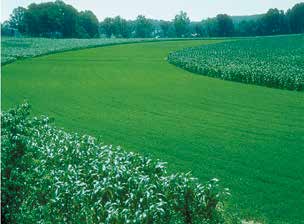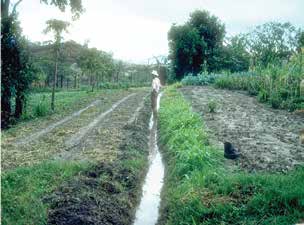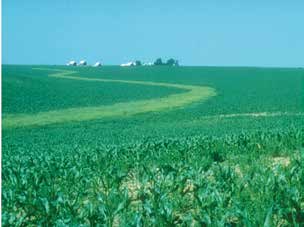chAPter 14 reduCing erosion and runoFF
than incorporated. Ideally, this is done when the cover
Benefits are greatest when such rotations are combined
crop has nearly matured (typically, milk stage)—that
with reduced- and no-tillage practices for the annual
is, when it is somewhat lignified but seeds are not yet
crops. Perennial crops like alfalfa and grass are often
viable and C:N ratios are not so high as to cause nutrient
rotated with row crops, and that rotation can be readily
immobilization. In recent years, new methods of cover
combined with the practice of strip cropping (figure
cropping, mulching, and no-tillage crop production,
14.5). In such a system, strips of perennial sod crops and
often jointly referred to as conservation agriculture,
row crops are laid out across the slope, and erosion from
have been worked out by innovative farmers in several
the row crop is filtered out when the water reaches the
regions of the world (figure 14.4; see also the farmer case
sod strip. This conservation system is quite effective in
study at the end of this chapter). In parts of temperate
fields with moderate erosion potential and on operations
South America this practice has revolutionized farming
that use both row and sod crops (for example, dairy
with rapid and widespread adoption in recent years. It
farms). Each crop may be grown for two to five years on
has been shown to virtually eliminate runoff and erosion
a strip, which is then rotated into the other crop.
and also appears to have great benefits for moisture con-
Permanent sod, often as pasture, is a good choice
servation, nitrogen cycling, weed control, reduced fuel
for steep soils or other soils that erode easily, although
consumption, and time savings, which altogether can
slumping and landslides may be a concern under
result in significant increases in farm profitability. See
extreme conditions.
chapter 10 for more information on cover crops.
Adding Organic Materials
Perennial Rotation Crops
Maintaining good soil organic matter levels helps keep
Grass and legume forage crops can help lessen ero-
topsoil in place. A soil with more organic matter usually
sion because they maintain a cover on most of the soil
has better soil aggregation and less surface crusting.
surface for the whole year. Their extensive root systems
These conditions ensure that more water is able to
hold soil in place. When they are rotated with annual
infiltrate the soil instead of running off the field, taking
row crops, the increased soil quality will reduce erosion
soil with it. When you build up organic matter, you
and runoff potential during that part of the crop cycle.
help control erosion by making it easier for rainfall to
Figure 14.4. Field and close-up views of soybean grown in black oat cover crop mulch in South America. Photos by Rolf Derpsch.
157
Building SoilS for Better CropS: SuStainaBle Soil ManageMent











